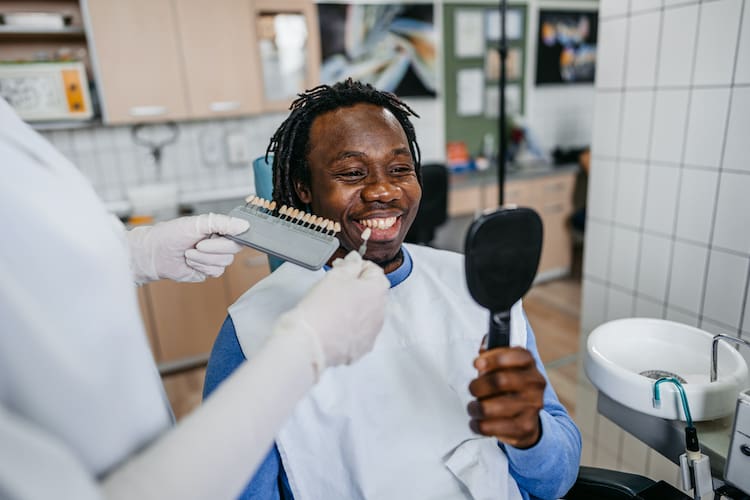Do you have a cosmetic blemish you wish you could hide?
Dental bonding is a simple solution for repairing minor damage or cosmetic issues that impact your smile. The dental team at Claremont Dental Institute offers tooth bonding in Claremont, CA, to can help to restore a tooth’s natural aesthetic. This cosmetic dentistry treatment is affordable and does not require the long-term commitment of dental veneers. Tooth bonding is a painless procedure, since no drilling or anesthesia is usually necessary.
Claremont Dental Institute provides dental bonding for children, teens, and adult patients. Our dentists use dental technology with their advanced skill set to provide patients with natural results.

What is Dental Bonding?
Bonding is a malleable plastic resin material that your dentist bonds to your tooth. He molds and shapes the bonding into the desired shape while on the tooth allowing for a more precise outcome. Your dentist will also match the color of the resin to the tooth for a seamless result. The dental resin is durable and stain-resistant.
Our dentists can use dental bonding to fill a tooth cavity or to restore a damaged or broken tooth. Dental bonding can also improve the appearance of a discolored or misshapen tooth. In some cases, bonding can address exposed tooth roots because of a receding gum line, or close small gaps between teeth.
Dental bonding can address the following issues:
- Repair decayed teeth.
- Repair chipped or cracked teeth.
- Improve the appearance of discolored teeth.
- Close spaces between teeth.
- Make teeth look longer.
- Straighten irregularly-shaped teeth.
- Change the shape of teeth.
- Protect a portion of exposed tooth root when gums recede.
- Enhance the shape of a tooth to correct the bite.
Is Dental Bonding Right for Me?
If you are embarrassed by your smile or you suffer from gaps between your teeth, dental bonding may be the perfect solution. Bonding is also effective and natural-looking for patients who need a short-term option for improving the look of their smile.
If your tooth has unexpected damage, bonding is a more affordable way to repair it right away. It may also help prevent secondary dental concerns from developing.
Our dentists may recommend dental bonding for your child or teen’s damaged teeth as well. The painless and a relatively quick procedure is an ideal treatment choice for young patients. Furthermore, a dentist can remove bonding down the road and replace it with porcelain veneers once your child’s smile matures.
To learn about the difference between dental bonding and porcelain veneers, visit Teeth Bonding Vs. Porcelain Veneers. Some more benefits of dental bonding include:
- Little to no removal of enamel, retaining the health and natural structure of your tooth.
- Less extensive procedure rather than restorations like porcelain veneers or dental crowns.
- The procedure is complete in one appointment.
The Dental Bonding Procedure
Tooth bonding is a cosmetic dental procedure we use to address a variety of issues for our patients. A dental exam with your Claremont Dental Institute dentist will help decide if dental bonding is the right fix for your concerns.
We provide comprehensive dental exams before all procedures. This will ensure that we address underlying functional issues, allowing for more stable and healthy results.
The dental bonding treatment is simple, quick, and effective. Patients are usually able to receive treatment with only a local anesthetic for their optimal comfort. Typically, patients can have the appearance of their tooth restored in just a single visit to our office.
Your dentist will gently remove a minimal amount of the tooth’s surface in preparation for the bonding resin. Your dentist will place the bonding directly onto the prepared tooth and form the material into the desired shape.
During this process, your dentist will keep an open line of communication with you. Only you can give us the final approval.
Once you and your dentist are happy with the shape and color of the dental bonding, he will use a special light to harden the material. The light activates the resin’s hardening agent and seals the bonding in place. Next, your dentist will polish the tooth to a natural shine. The bonded tooth will be indistinguishable from neighboring teeth.
Does Bonding Require Special Aftercare?
Bonded teeth do not require special maintenance. Simply follow good oral hygiene practices. Brush teeth at least twice a day, floss at least once a day, and rinse with an antiseptic mouthwash once or twice a day.
However, avoid habits like biting fingernails, chewing on pens, ice, or other hard food objects. Bonding material is not unbreakable and can chip and crack. In addition, it is important to continue a regular dental hygiene routine and to attend regular dental check-ups. Visit Claremont Dental Institute for regular professional check-ups and cleanings.
What Are the Alternatives to Dental Bonding?
We also offer other cosmetic dental services that provide a more permanent way to alter your teeth. They are porcelain veneers and dental crowns. We can design each one to meet your unique needs and aesthetic goals.
Porcelain veneers are thin shells that your dentist will custom create to cover the front surfaces of teeth. They are more stain-resistant than dental bonding and can fix more cosmetic concerns. However, they require more tooth preparation than bonding. To learn more about the dental veneer process, see Porcelain Veneers.
Dental crowns are cap-like dental restorations that cover the entire tooth. The cap will extend down to the gum line. We can apply them to teeth requiring a lot of cosmetic work. We will take a mold of your teeth and use them to create the custom crown.
Then, the dentist will reduce the tooth size and cement the custom crown on the tooth. To learn more about dental crowns, see Dental Crown.
Dental Bonding FAQs
Dental bonding is a simple and effective treatment that can address many dental issues. Read through our frequently asked questions to learn more. Call our dental office if you have additional questions or concerns.
How long will my tooth bonding last?
Your tooth bonding results can last between 3 and 10 years. You may need to touch up or replace tooth bonding every few years because it’s not a permanent treatment. A few factors will determine when you will need touch ups or re-bonding for your teeth. For example, how much bonding material the dentist uses and how well you maintain your teeth.
With good at-home oral hygiene and routine dental health checkups, dental bonding can last for up to 10 years and sometimes longer. Consider porcelain veneers for a more permanent and lasting result.
Will tooth bonding make my teeth more sensitive?
Some patients may feel some tooth sensitivity right after treatment. This typically goes away after your tooth adjusts to the bonding material. We suggest you avoid eating hot or cold foods for the first day after treatment. This will prevent any discomfort or shock to your system.
Is tooth bonding expensive?
Tooth bonding is the most affordable cosmetic dentistry option available. It involves little tooth preparation and materials, and the process is fast. However, the cost of tooth bonding can vary depending on how complex the procedure is. Your dentist must assess your mouth and cosmetic issues before providing a price for the procedure.
Are there any risks or disadvantages of tooth bonding?
Tooth bonding is generally a safe treatment. However, the resin is less strong than natural enamel, so it’s possible for the bonding to wear down over time. Also, some resins are more prone to discoloration. So practice good oral hygiene habits and visit your dentist regularly for proper upkeep.
Is dental bonding painful?
The tooth bonding treatment does not typically cause pain. The process only involves a slight amount of modification to the tooth. This will not impact the nerves, making anesthesia unnecessary.
However, you may feel tooth sensitivity or discomfort during the visit when your dentist prepares your tooth’s surface. This is mild and brief. Most people report that the treatment is easy and pain-free.
We may only recommend anesthesia when you are receiving tooth bonding to treat tooth decay. In these cases, the dentist will need to remove the decayed portion of the tooth. This may be uncomfortable and painful without anesthesia.
Can dental bonding replace missing teeth?
No, dental bonding cannot replace missing teeth. However, we can use it with other procedures, such as dental bridges, to improve your smile. In this case, your dentist would use the bonding material to shape the anchor tooth. The anchor tooth will provide a more secure fit for the dental bridge.
Dentures, dental bridges, and dental implants are the most common solutions for missing teeth. These provide permanent solutions that will allow you speak, eat, and smile with confidence again.
Is tooth bonding a permanent solution?
No, we consider dental bonding a semi-permanent solution. The treatment will last several years with proper care; however, bonding is not as durable as other dental restorations. A dental crown or porcelain veneer is much stronger and is a permanent cosmetic treatment.
The tooth-colored composite resin we use in bonding is more susceptible to wear and tear. Over time, it is more likely to chip and stain and will require replacement. However, the tradeoff is that it’s versatile, still delivers beautiful results, and is affordable.
How long does a dental bonding procedure take?
The bonding process is fast and easy. Your dentist can complete the treatment in one visit, taking about 30 minutes to one hour per tooth. However, the exact length of your treatment may vary depending on the complexity of your case. Once we assess your teeth, we will provide you with a better timeline.
Can children get tooth bonding?
Tooth bonding is a great treatment for children who have minor tooth damage, such as chips, cracks, or decay. The process is minimally-invasive, and your dentist can complete it quickly without anesthesia. We can also match it to the color of the child’s teeth. When the child fully matures, they can replace the bonding with a dental crown or porcelain veneer if necessary.
